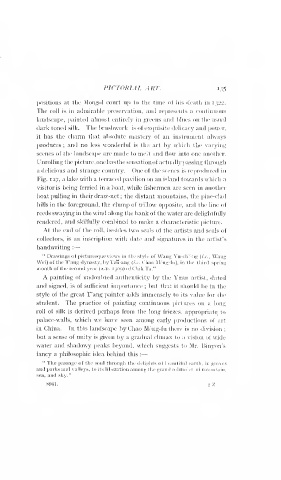Page 395 - Chinese Art, Vol II By Stephen W. Bushell
P. 395
—
—
nCrORIAL ART. 135
positions at the Mongol court up to the time of his death in 1322.
The roll is in atimirahlc ]ireservation, and represents a continuous
landscape, painted almost entirely in greens and blues on the usual
dark toned silk. The brushwork is of exquisite delicacy and power,
it has the chann that absolute mastery of an instrument always
produces ; and no less wonderful is the art by which the varying
scenes of the landscape are made to melt and flow into one another.
Unrolling the picture, onehasthesensationof actuallypassing through
a delicious and strange country. One of the scenes is reproduced in
Fig. 127, a lake with a terraced pavilion on an island towards which a
visitor is being ferried in a boat, while fishermen are seen in another
boat pulling in their draw-net ; the distant mountains, the pine-clad
hOls in the foreground, the clump of willow opposite, and the line of
reeds swaying in the wind along the ijank of the water are delightfully
rendered, and skilfully combined to make a characteristic picture.
At the end of the roll, besides two seals of the artists and seals of
collectors, is an inscription with date and signatures in the artist's
handwriting :
" Drawings of picturesque views in the style of Wang Yu-ch'eng {i.e., Wang
Wei) of the T'ang dynasty, by Tzn-ang {i.e. Chao Mrng-fii), in the third spring
month of tlie second year (a.d. 1309) of Chili Ta."
A painting of undoubted authenticity by the Yuan artist, dated
and signed, is of sufficient importance ; but that it should be in the
style of the great T'ang painter adds immensely to its value for the
student. The practice of painting continuous pictures on a long
roll of silk is derived perhaps from the long friezes, appropriate to
palace-walls, which we have seen among early productions of art
in China. In this landscape by Chao Meng-fu there is no division
;
but a sense of unity is given by a gradual climax to a vision of wide
water and shadowy peaks beyond, which suggests to Mr. Binyon's
fancy a philosophic idea behind this :
" The passage of the soul through the delights of beautiful earth, in groves
and parks and valleys, to its liberation among the grand solitudes of mountain,
sea. and sky."
8941, -iZ

